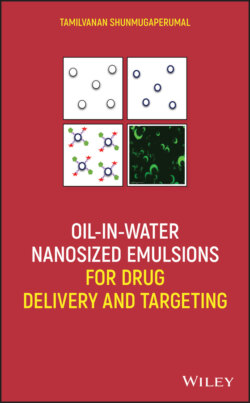Читать книгу Oil-in-Water Nanosized Emulsions for Drug Delivery and Targeting - Tamilvanan Shunmugaperumal - Страница 41
2.4.4. Incorporation of Antibodies, DNA Protein, Oligonucleotide, or Heat Labile Molecules
ОглавлениеBoth extemporaneous API addition (method A) into the preformed emulsion and de novo emulsion preparation (method B) are useful for the incorporation of heat labile molecules into the o/w nanosized emulsions. For example, cyclosporin A (peptidic molecule) was successfully incorporated without API degradation into the emulsion by following the de novo method (Tamilvanan et al. 2001). The extemporaneous addition of the solid API or API previously solubilized in another solvent or oil to the o/w nanosized emulsions is not a favored approach in technology wise as it might compromise the integrity of the emulsion. However, since therapeutic DNA and single‐stranded oligos or siRNA are water soluble due to their polyanionic character, the aqueous solution of these compounds need to be added directly to the o/w cationic nanosized emulsion in order to interact electrostatically with the cationic emulsion droplets and thus associate/link superficially at the oil–water interface of the emulsion (Teixeira et al. 1999; Tamilvanan 2004; Hagigit et al. 2010). During in vivo condition when administered via parenteral and ocular routes, the release of the DNA and oligos from the associated emulsion droplet surfaces should therefore initially be dependent solely on the affinity between the physiological anions of the biological fluid and cationic surface of the emulsion droplets. The mono‐ and di‐valent anions containing biological fluid available in parenteral route is plasma and in ocular topical route is tear fluid, aqueous humor, and vitreous. Moreover, these biofluids contain multitude of macromolecules and nucleases. There is a possibility that endogenous negatively charged biofluid's components could dissociate the DNA and oligos from cationic emulsion. It is noteworthy to conduct during the preformulation development stages an in vitro release study for therapeutic DNA and oligos‐containing cationic nanoemulsion in these biological fluids and this type of study could be considered as an indicator for the strength of the interaction occurred between DNA or oligo and the emulsion (Hagigit et al. 2008). Interestingly, the stability of oligos (a 17‐base oligonucleotide, partially phosphorothioated) was validated using a gel‐electrophoresis method. After incorporating the oligos into the cationic nanosized emulsion as well as during in vitro experiments of oligos‐containing emulsion in vitreous fluid at different time periods, the emulsions were phase separated by Triton X‐100 and then the degradation of oligos was also monitored following the same validated gel‐electrophoresis method (Hagigit et al. 2008). No appearance of new band was seen in comparison to the standard aqueous oligos solution. This result indicates that the oligos did not undergo degradation against the conditions applied to prepare a sterile emulsion.
In order to bring the nanosized emulsion closer to otherwise inaccessible pathological target tissues, homing devices/ligands such as antibodies and cell recognition proteins are usually linked somehow onto the particle surfaces. Various methods have been employed to couple ligands to the surface of the nanosized emulsions with reactive groups. These can be divided into covalent and noncovalent couplings. Noncovalent binding by simple physical association of targeting ligands to the nanocarrier surface has the advantage of eliminating the use of rigorous, destructive reaction agents. Common covalent coupling methods involve formation of a disulfide bond, cross‐linking between two primary amines, reaction between a carboxylic acid group and primary amine, reaction between maleimide and thiol, reaction between hydrazide and aldehyde, and reaction between a primary amine and free aldehyde (Nobs et al. 2004). For antibody‐conjugated anionic emulsions, the reaction of the carboxyl derivative of the coemulsifier molecule with free amine groups of the antibody and disulfide bond formation between coemulsifier derivative and reduced antibody were the two reported conjugation techniques so far (Song et al. 1996; Lundberg et al. 1999, 2004). However, by the formation of a thio‐ether bond between the free maleimide reactive group already localized at the o/w interface of the emulsion oil droplets and a reduced monoclonal antibody, the antibody‐tethered cationic emulsion was developed for active targeting to tumor cells (Goldstein et al. 2005, 2007a, b).
